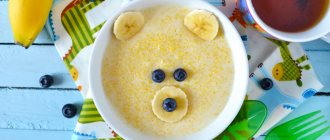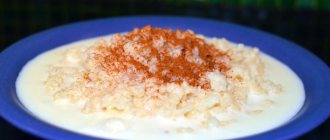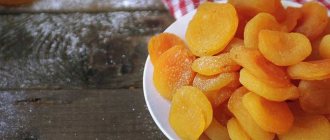Composition, beneficial and harmful properties of semolina
Semolina is wheat cereal, which is made by special grinding. The size of the grains varies from 0.2–0.7 mm. Produced from soft, hard and combined varieties of wheat.
The composition contains vitamins and minerals necessary for the normal functioning of the body: PP (1.2 mg), E (0.25 mg), B, H, as well as Ca (20 mg), Mg (18 mg), potassium (130 mg ), silicon, phosphorus (85 mg).
Introducing porridge into the diet brings undeniable benefits:
- the energy supply increases - carbohydrates tend to be quickly absorbed, filling the body with an energy charge;
- the functioning of the nervous system is normalized - this is facilitated by folic acid and B vitamins;
- the skeletal system is strengthened - calcium and silicon promote tooth growth;
- digestive function is normalized - the porridge envelops the stomach, relieves spasms, is digested in the lower intestine and does not irritate its walls;
- the cardiovascular system is strengthened - magnesium and potassium “force” the heart muscle to work better;
- immunity is increased and the normal functioning of the body is ensured.
Semolina is recommended to be consumed during rehabilitation after serious illnesses and operations. It has a high energy value, which contributes to the rapid recovery of the body.
Despite the benefits, pediatricians do not recommend getting carried away with semolina, much less introducing it into the first complementary foods. The fact is that it contains substances that can cause unwanted reactions in the body:
- Gluten is a plant protein that provokes the development of allergies. It is difficult for immature digestive organs to cope with a possible allergen, so the risk of unpleasant symptoms increases several times;
- phytin - binds calcium, the body stops absorbing it. When the level of calcium in the bloodstream decreases, the parathyroid glands pull it from the bones, which provokes the occurrence of rickets. In addition, it becomes more difficult for the body to absorb vitamin D and iron;
- glyodine - regular entry into the digestive tract leads to the fact that the intestinal villi, which are responsible for the normal absorption of nutrients, begin to die. As a result, gastritis and colitis develop.
Why is semolina introduced into the diet little by little?
The digestive system of infants is not yet mature enough and is not able to cope with the digestion of vegetable protein, which is present in semolina. Therefore, feeding large meals daily can strengthen and cause constipation.
Eating cereal is strictly prohibited if you are gluten intolerant. In this case, the diet will need to be followed for the rest of your life.
In addition, negative manifestations appear if you consume only one semolina as an additional food.
When introducing the product, be sure to monitor the baby's reaction.
If an allergic reaction occurs (rash, itching), semolina should be immediately excluded from the diet.
Video: dangerous foods for children - semolina porridge - Malysheva
The benefits and harms of semolina for an infant
Our grandmothers and mothers were absolutely sure that semolina porridge is the best thing that can be given to a child of any age. It is undoubtedly nutritious and easy to eat, but modern research has also proven the negative aspects of the product.
What do doctors think?
Why shouldn’t semolina porridge be introduced as a first complementary food? Let's look at the main reasons:
- Reduces calcium levels in the body. This happens due to the fault of phytin, which is contained in semolina. Phytin itself has a positive effect on the liver and is a weak antioxidant, but for the baby’s body its ability to bind calcium plays a decisive role, and for a growing body this substance is the most necessary;
- Contains gluten. The substance quite often causes allergic reactions in the body of infants. The sooner a baby tries it, the higher the likelihood of developing celiac disease (gluten enteropathy). The main manifestation of the disease is a violation of absorption processes. As a result, the level of vitamins, microelements and proteins in the blood decreases. Consequences - various diseases associated with a lack of elements: baldness, bone pain, frequent acute respiratory viral infections, furunculosis, caries, food allergies, etc.;
- The absorption of iron and vitamin D is impaired.
Semolina is highly undesirable as a first complementary food, because the main substance needed by the body at this stage of development is calcium, and everything that interferes with its absorption in the body must be excluded.
Useful: - it is important to know in order to prevent allergies and not overload the baby’s body. .
More details about fitin. It contains phosphorus, one of the abilities of which is the binding of calcium salts. When this process occurs when eating semolina, phosphorus binds all the calcium in the intestines, thereby preventing it from entering the blood. The body is programmed to maintain a certain level of calcium salts in the blood, and when there is a shortage, the parathyroid glands extract calcium salts from deposits already present in the body - from the bones. The glands “wash out” salts, weakening the bones. Due to rapid growth, there is a lack of calcium in the body, which leads to problems with the heart, blood, muscle function, even seizures.
Phytin affects the intestinal environment, interfering with the absorption of calcium and vitamin D that enter the body with food. Infants who eat semolina from early months (from 4 months) suffer from rickets and spasmophilia.
There is no need to despair; semolina also has positive aspects, also scientifically proven:
- protein. The abundance of its content in semolina is a powerful argument for introducing porridge into the baby’s regular menu;
- the proportion of starch in semolina is 70%. It is an important source of energy for a growing organism;
- semolina contains vitamins E, PP and group B;
- many minerals (magnesium, potassium, iron, calcium, sodium, etc.).
The advantage of semolina porridge is undoubtedly its satiety. In addition, it cooks very quickly, which allows you to preserve maximum nutrients.
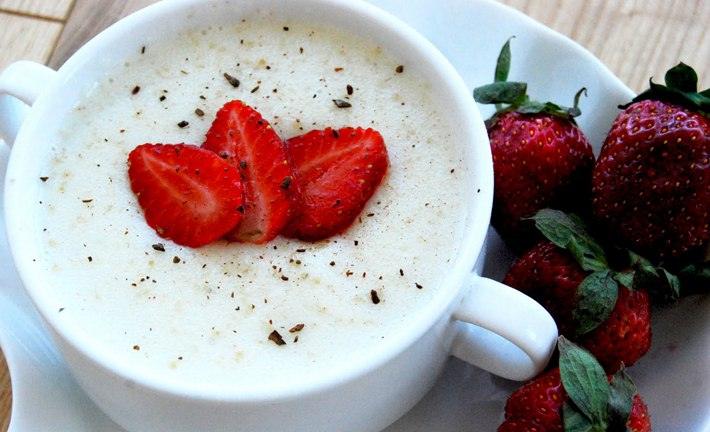
Thus, semolina cannot be considered absolutely useless for babies. You just need to wait until a certain age when you can safely give it to your child.
Semolina porridge when breastfeeding a newborn
Without a doubt, breast milk is the best food for a baby. A young mother should eat properly so that the baby receives all the nutrients while breastfeeding. Some people prefer a strict diet with a one-month or two-month-old baby, and some do not limit themselves in foods, but whatever the choice, take into account the opinions of doctors.
Semolina porridge can be consumed by women while breastfeeding, but some recommendations should be followed:
- It is not recommended to include cereals in the menu until the baby is 2 months old, and if there is colic - up to 3 months.
- For the first time, it is recommended to eat a small portion (up to 100 g) of semolina, not on an empty stomach. You should monitor the baby's condition for two days. If no negative reactions are observed, the portion is increased to 200–250 g.
- Until the baby reaches three months of age, it is better for mom to cook porridge in water, diluting it with milk 1:1.
- Semolina is best eaten for breakfast, no more than once a week.
Semolina
Appetizing, tender and airy semolina porridge is a favorite of mothers and little gourmets. It quickly and deliciously satisfies the appetite and charges the baby with additional energy. Semolina porridge, which does not contain salt, is best introduced into the child’s menu at the second stage of complementary feeding. Semolina porridge is rich in dietary fiber, which improves intestinal motility. It contains B vitamins, iron and magnesium, which help normalize metabolism, increase hemoglobin and harmonious development of the muscular system.
A special feature of semolina is its high starch content and low fiber content, so porridge from it is high in calories and is easily digestible by the baby. It is a rich source of B vitamins, which also contains potassium, phosphorus, iron, cobalt, manganese, zinc and fluoride.
When your little gourmet turns 6 months old, mommy's milk can no longer provide him with enough vitamins and minerals he needs to fully grow and develop. At this very time, you need to start expanding your baby’s usual diet, introducing her to foods of different types and tastes - complementary foods. At the first stage of introducing complementary foods, the baby traditionally gets acquainted with the taste of vegetable purees. When the baby gets used to the new treat and begins to eat a full portion of such complementary foods, you can move on to the next stage and add a new dish to the collection of his taste sensations - baby milk porridges.
The first porridge a baby will try in his life should be buckwheat or rice. In addition to the fact that they do not contain gluten, which can cause allergies in infants, they are also rich in iron, which is especially necessary for the proper development of your little fidget after he turns six months old. Since semolina contains gluten in its composition, it is better to introduce it to your baby a little later, when she has already tried gluten-free milk porridges.
The porridge that your little champion is just beginning to taste should be sufficiently liquid and uniform in consistency so that the baby does not have any difficulty swallowing such a product after breast milk. You need to introduce semolina porridge into your baby’s diet, like any food product, gradually. To begin with, during daytime feeding, offer him 0.5-1 teaspoon of semolina to try and give him milk, which he loves so much. There is no need to force your baby to eat semolina if he doesn’t like it the first time. It's better to wait a little and try again. But if your little angel has tried a new complementary food product, gradually increase its amount to a full portion of 100-150 g per feeding.
To prepare milk semolina porridge for your baby, you can use your own milk or baby formula if your baby is mixed-fed. Also, in order to give a familiar dish new shades of taste and develop the correct taste sensations in the baby from childhood, you can cook porridge with vegetable decoctions.
At the same time, mothers need to remember that sugar, salt, as well as spices and sweeteners should not be used to prepare complementary foods for your baby until he is at least 24 months old.
Moms can choose commercially produced milk and dairy-free porridges for their little fidget. Such porridges are ideal for the second stage of introducing complementary foods, as they are enriched with all the vitamins and minerals a baby needs at this age, so you can be sure that your baby will receive everything to develop harmoniously.
When your little one tastes the new delicacies on his menu and enjoys devouring all kinds of porridges and vegetable and fruit purees, you can significantly diversify the familiar menu of your little connoisseur with a delicious multi-grain porridge. In addition, the presence of different grains in the porridge will give the baby even more nutrients for growth.
When your baby can show off his teeth and starts biting the spoon during feedings, it’s time to switch to a thicker and less uniform porridge that he can chew on his own. For better development of chewing skills, you can offer your baby semolina porridge with small pieces of fruit. Your little champion will undoubtedly be delighted with this dish!
It’s good if, from childhood, you teach your baby healthy food and develop a culture of nutrition in her. Feeding your baby together with the whole family will greatly contribute to this. Place your treasure at the same table with adults, give him a spoon so that he can eat his favorite treats himself, and actively involve the baby in the feeding process.
Even at an older age, semolina porridge with its delicate soft taste will become a pleasant variety in the baby’s daily menu and will give him the necessary nutrients, vitamins and minerals for growth and development.
The right choice of semolina for babies
If you prefer to cook porridge from regular semolina, you should pay attention to the following factors:
- GOST sign means that quality standards for processing methods have been met;
- category - the sign “MT” or “M” indicates that the cereal was obtained from soft varieties. It contains a lot of gluten, but few nutrients. The “T” sign indicates that the cereal is made from durum wheat. It is more preferred, but it is difficult to find on sale. Therefore, doctors recommend purchasing already packaged mixtures, where all the elements are balanced;
- color - a pinkish tint indicates that the cereal was obtained from durum varieties. White semolina is made from soft grain and is not suitable for children.
Purchase goods only in transparent packaging - this way you can see the structure, color, presence of lumps and other inclusions.
When choosing semolina in infant formula, preference is given to reliable manufacturers. Pediatricians consider this method the most acceptable, since the cereal undergoes mandatory processing.
Selecting semolina: photo gallery
How to start and how much porridge to introduce into your baby’s diet
Don’t be scared and completely eliminate semolina from your diet, because it is a healthy and necessary product for kids. Before giving wheat porridge to your baby, you should listen to the recommendations of pediatricians.
Doctors recommend introducing porridge into the baby’s menu after 12 months, when the functioning of the digestive and enzyme systems improves. If the child has persistent underweight, then it is allowed to give semolina after 6 months.
Semolina has the ability to swell in the gastrointestinal tract. After eating you feel full for a long time. Therefore, if you feed your child porridge at night, you can be sure that he will be full until the morning.
Parents should keep in mind that you can feed your baby semolina no more than once every 10 days..
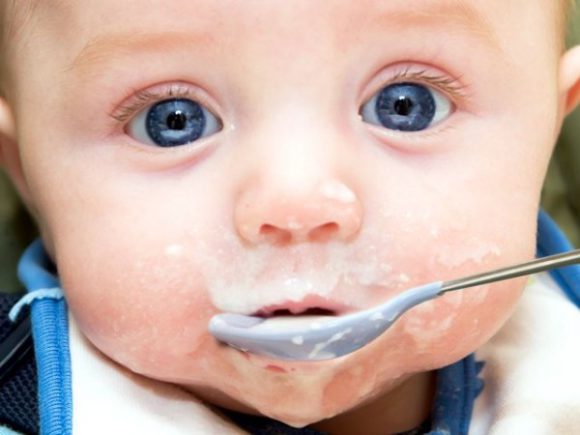
Complementary feeding starts with a small portion
They start feeding with half a teaspoon of porridge. If there are no negative manifestations, the portion next time is doubled.
First, the porridge is prepared with a liquid consistency, then more viscous. After about a month and a half, you can add 5 g of oil. You should feed your baby not from a bottle, but from a spoon. In order not to miss the baby's reaction to a new product, it is better to give semolina in the morning.
Recipes and cooking features
If a child tries semolina for the first time, it must be prepared in water. The cereal is ground in a coffee grinder to turn it into flour.
Porridge with water for children under one year old
For children under one year old, porridge is prepared as follows:
- Boil water (200 ml).
- Prepare 2 teaspoons of ground cereal.
- Gently pour into boiling water in a thin stream.
- Stir the mixture constantly to prevent the formation of clots.
If you can’t pour semolina from a spoon, make a funnel out of a clean paper sheet and carefully pour it into the liquid. Cook for no more than 7-10 minutes, otherwise it will become too thick.
Before feeding, add a little breast milk to the finished dish. If the child is artificial, use standard milk formula.
Thick porridge begins to be prepared for children after one year. It can already be boiled in milk, which should be diluted with water in a 1:1 ratio.
Preparing thick porridge with milk for a one-year-old child
- Boil water (100 ml), add cereal (2 tablespoons).
- Pour in heated milk (100 ml).
- Add a pinch of salt and ½ teaspoon of sugar.
- After boiling, cook the porridge for 7 minutes.
- Turn off, add 5 g of butter.
How to cook liquid semolina porridge using baby food
If your baby absolutely does not eat dairy products or is intolerant to milk, they can be replaced with baby formula.
First, semolina is prepared in the usual way using water. After the mass has cooled, add milk mixture to it at the rate of 1.5 tablespoons of baby food per 100 g of finished porridge.
It must be remembered that the mixture should not be heated too much, much less boiled. Otherwise, all the beneficial substances will disappear.
Recipes for semolina porridge with additives
To make your baby's diet varied, as well as to introduce new tastes, you can add various ingredients to semolina.
Porridge is often prepared with dried fruits, oatmeal, pumpkin, corn flakes, and banana.
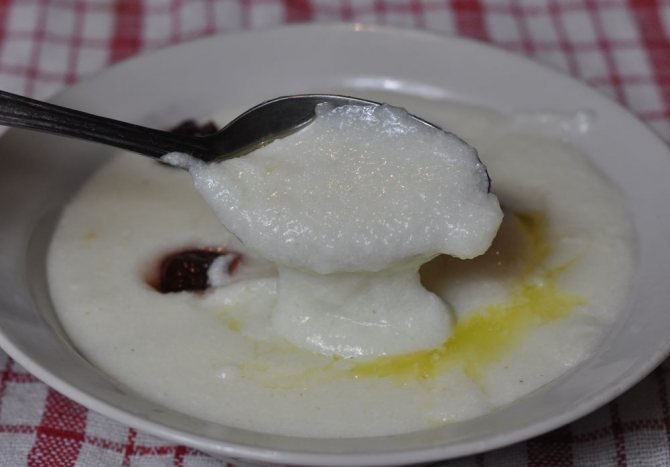
Semolina porridge with sweet additives - healthy and tasty
How to cook semolina with pumpkin
Pumpkin is one of the first foods that a baby is introduced to from the age of 6 months. This is explained by the fact that it has a fibrous structure and has a beneficial effect on the baby’s digestive system.
To prepare porridge you will need:
- Peel and seeds, cut into small pieces 100 g of pumpkin.
- Pour in water so that the liquid only slightly covers the product.
- Boil for 15–20 minutes until softened.
- Grind in a blender until pureed.
- Pour 200 ml of milk into the resulting mass.
- Bring to a boil and add 1 tablespoon of semolina.
- Cook for 7 minutes.
The more intense the color of the pumpkin, the brighter the dish.
How to cook semolina with carrots
Recommended for children over 1 year of age. Prepare as follows:
- Peel half of the medium root vegetable and chop on a grater.
- Place in a saucepan, add 5 g of butter.
- Simmer over low heat for 2-3 minutes.
- Pour warmed milk (200 ml) into the mixture.
- Lightly salt and add ½ teaspoon of sugar.
- Add 1 tablespoon of cereal to the boiling mass and simmer for 5–7 minutes.
How to cook semolina with fruit puree
- Cook liquid semolina porridge in water.
- Stew 50 g of fresh apples or dried fruits in a small amount of water for 5 minutes.
- Grind the fruit mixture into a fine sieve.
- Mix apple puree with the prepared porridge.
Semolina porridge with additives: photo gallery
How to cook semolina porridge for a child
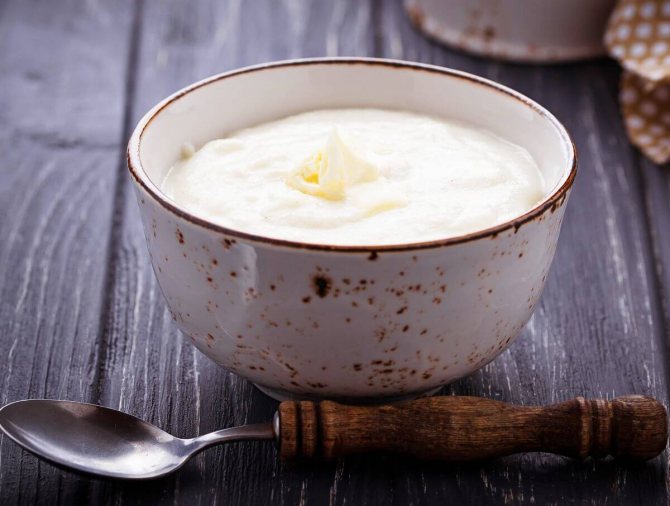
For porridges, you can buy cereals marked “T” or “TM”. It is better to choose a product in transparent packaging. Children under 1.5–2 years old are recommended to cook porridge with water or diluted milk, if casein and lactose are well tolerated. Children 2 years and older can eat milk semolina.
Adding jam, sugar or butter to a dish is allowed only if you are not overweight. Otherwise, due to its high calorie content and the presence of starch, such porridge will quickly lead to the development of obesity.
Recipes for semolina porridge for children
Up to 2 years, it is recommended to prepare liquid ones in the following proportion: 1 part cereal to 5 parts water, broth or milk. Older children can cook thick porridge: 1:3. Occasionally, it is allowed to add semolina to pancakes, casseroles and other baked goods.
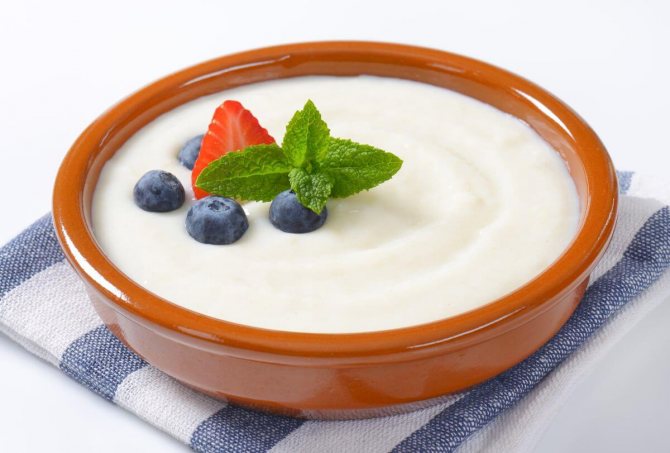
Semolina porridge with milk for a child
For a serving of porridge, in a suitable container, heat a glass of milk to a boil and add 3 tsp in a thin stream. decoys. To cook without lumps, you can pre-mix the cereal with a few tablespoons of cold milk. Cook, stirring, until the semolina swells and becomes thick. At the end, add salt.
Experts' opinions on the benefits and harms of semolina: to feed or not to feed
The opinions of pediatricians and gastroenterologists about when to start feeding semolina are contradictory. The fact is that in itself it is not dangerous for the baby’s health, if it is not given every day, and also if the child does not have gluten intolerance.
Dr. Komarovsky also did not include cereal in the list of ingredients for the first complementary foods. He believes that if the baby is breastfed, then until 6 months. there is no need to “strengthen” his diet with fruits, vegetables, and especially cereal products.
Most doctors believe that complementary feeding should start with gluten-free cereals, such as rice or buckwheat. In addition, semolina should not be given to children who have a tendency to allergic manifestations, have indigestion, intestinal problems, or are overweight.
